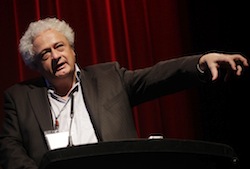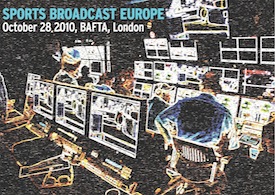
TVBEurope’s Sports Broadcast Europe conference is unique because it examines the technology and operational drivers and imperatives behind the coverage of high-profile sporting events – from a European perspective. Gabriel Fehervari, Alfacam’s CEO, provided the opening keynote
The day opened with a stimulating presentation from the head of one of Europe’s busiest outside broadcast contractors: Gabriel Fehervari, the CEO of Alfacam. He talked about some of the technical challenges in covering sport, and then set out his vision for the future: find create new sports that suit the television medium.
Fehervari described the scale of the Alfacam operation: 24 trucks and six flyaway kits; more than 300 HD cameras including 38 super slo-mo chains, and more than 70 EVS servers. “Our role is to offer new technologies,” he explained. “If we offer an OB with 12 cameras they will use 12. If we offer 20 they will use that.”
Looking at transforming technologies, he pointed to the wireless camera as offering great potential in sports coverage. “Up until a couple of years ago the problem was reliability,” he cautioned. “The quality is important. It must match the other cameras, and it must have low latency.”
Having tried the systems available, Fehervari commissioned Alfacam’s own technology, based on an airborne platform that, he said, gave good coverage in bad weather. The hub is a fixed wing plane, with GPS-controlled receivers in a fibreglass pod beneath the fuselage.
Big cycle road races, like the Tour de France, are covered by cameras on motorbikes and often with two helicopters, one at 200m for close-ups and one at 800m for the bigger picture. The Alfacam system allows for eight or ten stable wireless camera feeds, using MPEG-4, to be collected by the plane then streamed either direct to the truck or via a satellite if there is no clear line of sight.
“This makes covering triathlons live a possibility,” he said. Finding ways of presenting sport on television, whether it is a new event or a new way of looking at an existing game is what broadcasters should be looking at, he proposed.
“One way of building the business is by creating new sports,” Fehervari suggested. “Twenty20 cricket and the IPL is a great example of taking a boring sport and making it exciting for television.”
He went on to propose more sports ripe for a television makeover. “We are working with LEN [Ligue Européenne de Natation, which governs swimming in Europe] to totally change the sport of swimming. Apart from the big events, no-one watches swimming. Today water polo is boring, so change some things about it – smaller pools, smaller balls – and we could make it exciting.
“Cyclocross is very big in Belgium, but nowhere else,” he added. “We made it CityCross: one hour cycle races around cities. It has a much wider appeal, and we create new sporting heroes.”
Fehervari was firmly of the view that broadcasters should take control of the sporting content, rather than just sticking to the tried and trusted events and being at the mercy of the federations who charge big money for television rights. “We are involved in innovating in technology,” he said, “but we should also be innovating in the sports.”







